A Bitcoin Blockspace Boom
Bitcoin blockspace experienced a historically significant inflow of demand last week, as speculators rushed to mint BRC-20 tokens via text inscriptions. This resulted in immense fee pressure, driving miner fee revenue towards ATHs, and surpassing the 6.25 BTC block subsidy for the fifth time.
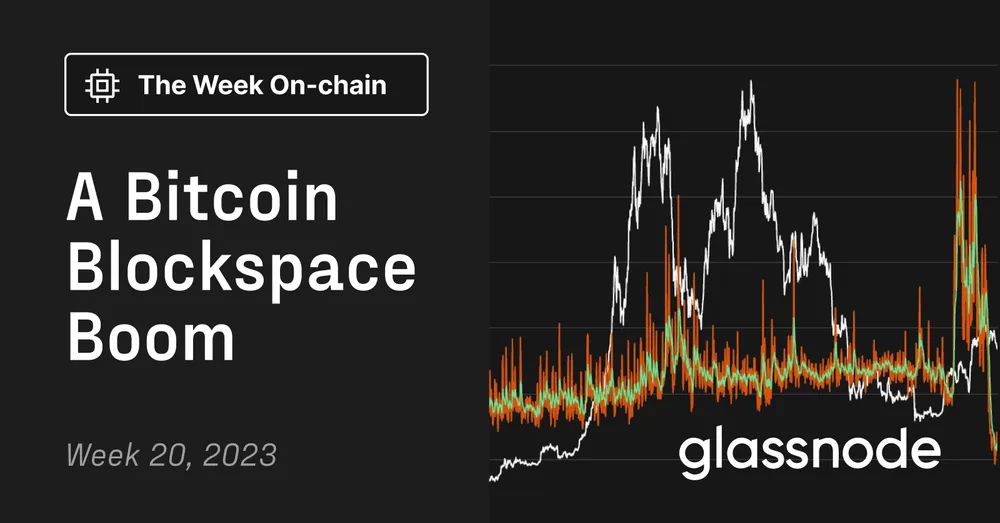
This week saw an explosion in demand for Bitcoin blockspace, as speculative interest in minting tokens, issued via text file inscriptions, pushed fees through the roof.
Transaction counts for Bitcoin reached new all-time-highs, and the average fee paid per block to miners surpassed the block subsidy of 6.25 BTC. Whilst it remains to be seen whether these BRC-20 tokens gain long-term traction, the brief bump in mining revenue was surely a welcome reprieve for miners after the savage bear market of 2022.
In this edition, we will explore the impact that demand for BRC-20 tokens have had for Bitcoin on-chain activity, inscription types, and miner revenues.
🪟 View all charts covered in this report in The Week On-chain Dashboard.
📽️ Visit and subscribe to our Youtube Channel, or visit our Video Portal for more video content and metric tutorials.
A New Demand For Bitcoin Blockspace?
This week, the Bitcoin network experienced a historically large inflow of demand for blockspace with the emergence of BRC-20 tokens. The shorthand summary of BRC-20 is that it is a proposed mechanism for issuing tokens on the Bitcoin ledger. The system leverages ordinal theory (see our report), and is enacted by inscribing JSON text files into the blockchain.
Given the small data footprint of text inscriptions, and large the fees BRC-20 users were willing to pay, miners were able to fill blocks with a record number of transactions. A new ATH daily transaction count of 682k was reached this week, eclipsing the 2017 peak by an incredible 39%.
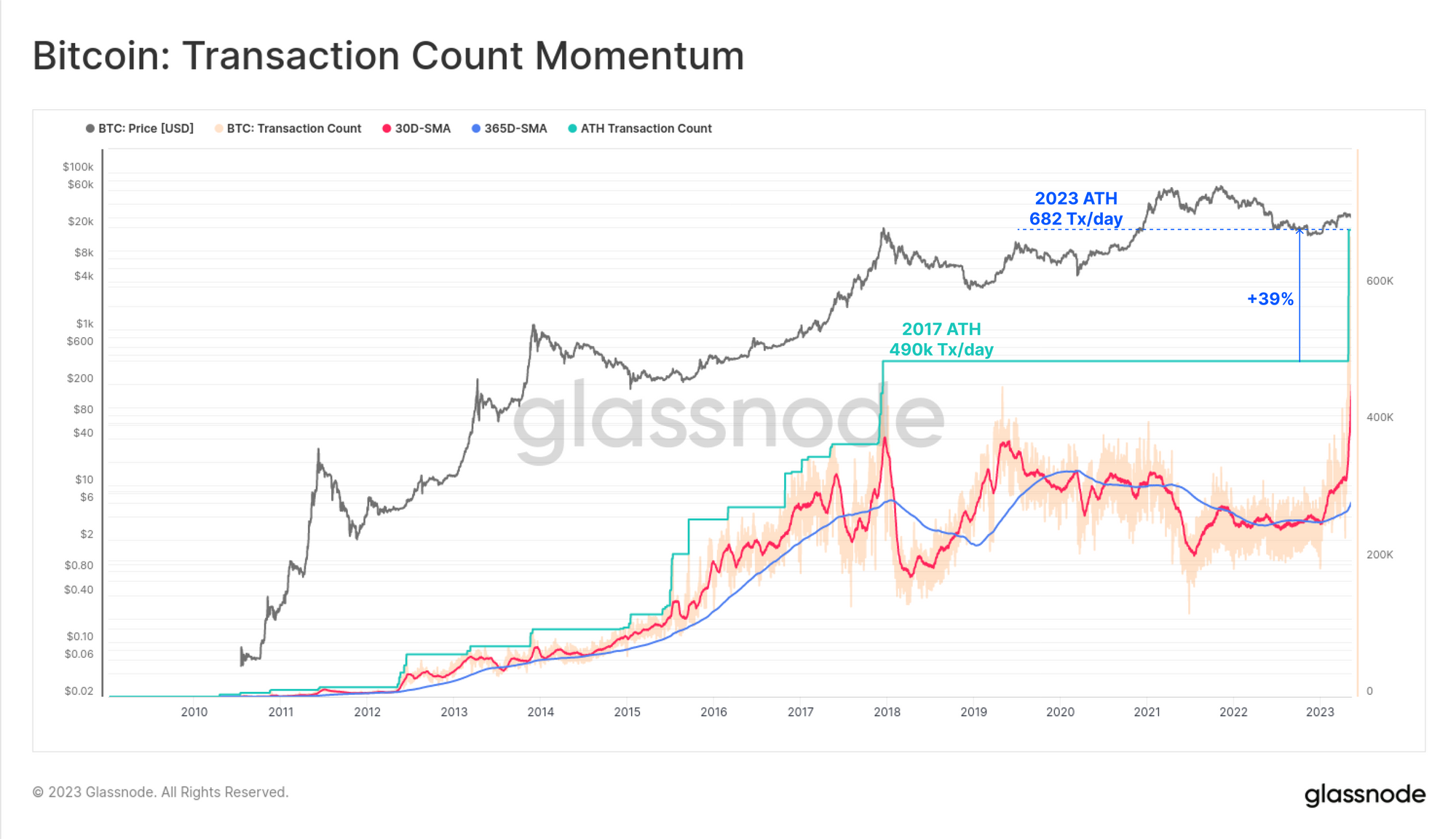
The average number of transactions per block more than doubled, increasing from the typical baseline of around 2k transactions per block, to over 4.3k per block. Since Bitcoin has a blocksize limit, such a significant increase in transaction counts is a direct result of inscriptions utilizing the 75% discount applied to witness data, thus allowing a denser consumption of available block capacity.
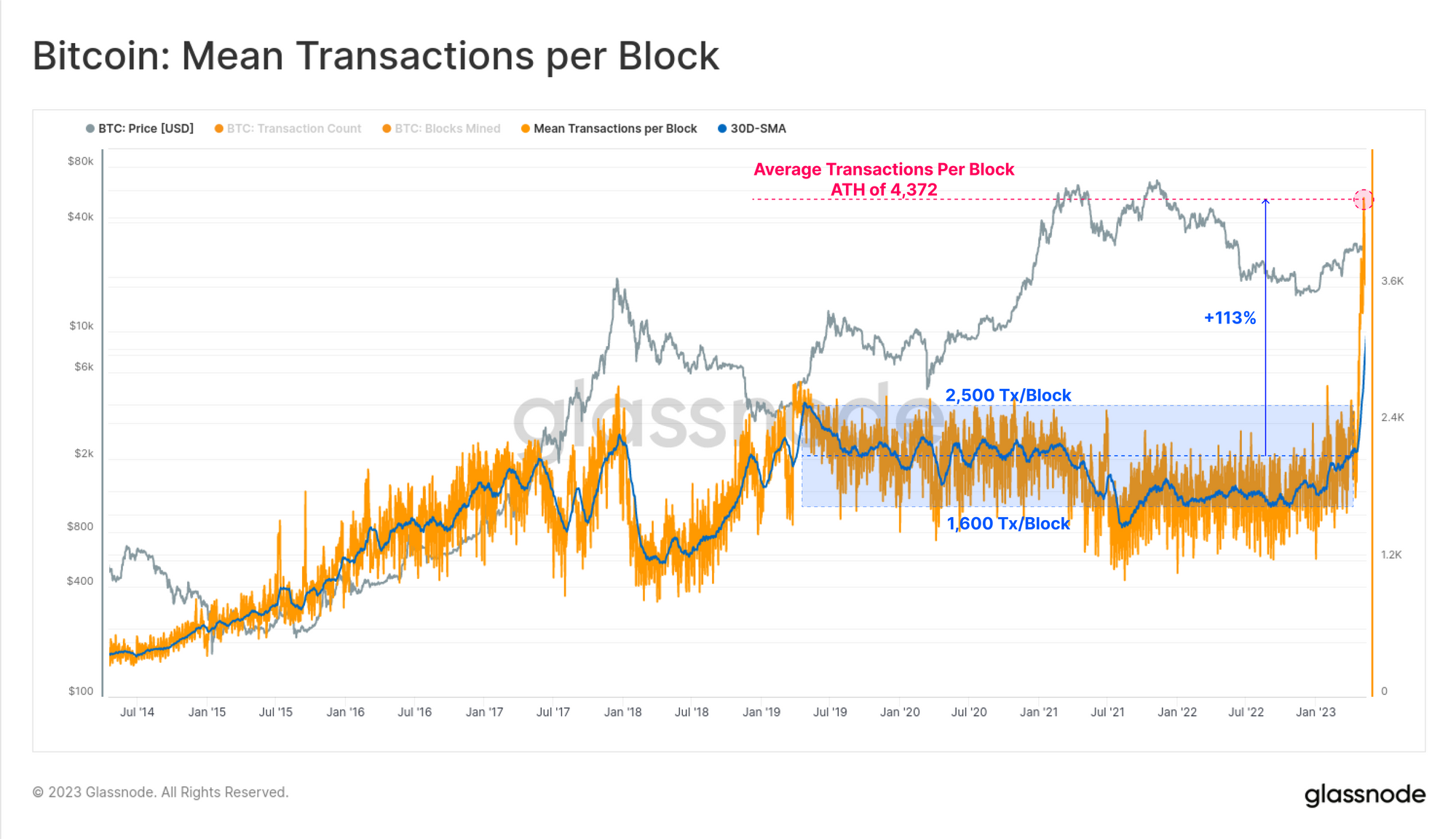
Interestingly, whilst transaction activity was booming, the number of active addresses fell to cycle lows of 566k addresses per day. This is a curious scenario, whereby many BRC-20 users appear to have re-used their Bitcoin addresses, perhaps due to having more familiarity with the way account based chains like Ethereum or Solana operate, and less so with the Bitcoin UTXO system.

Tsypruyan first identified this behavior, noting that 71% of transaction outputs were re-using addresses, an uptick from the ~50% baseline (which is largely associated with exchange wallet management).
Currently around 71% of #Bitcoin tx outputs are sent to previously used addresses. pic.twitter.com/BsuhNmlik4
— Tsypruyan (@tsypruyan) May 8, 2023
Text Takes Over
Since BRC-20 inscriptions are just small JSON text files, and take advantage of the 75% SegWit discount on witness data, their on-chain data footprint is relatively small. As a result, the average transaction size (in bytes) collapsed to 405 bytes, which is almost an all-time-low.
This is a full reversal from the first wave of primarily image based inscriptions seen in Q1, which reached new all-time-highs of ~1.5 kilobytes per transaction.

The explosion of text based inscriptions has left the first wave of images and files in the dust. In several instances throughout May, more than 350k text inscriptions were encoded to the chain in a single day, sustaining levels well above 250k/day over the last week.
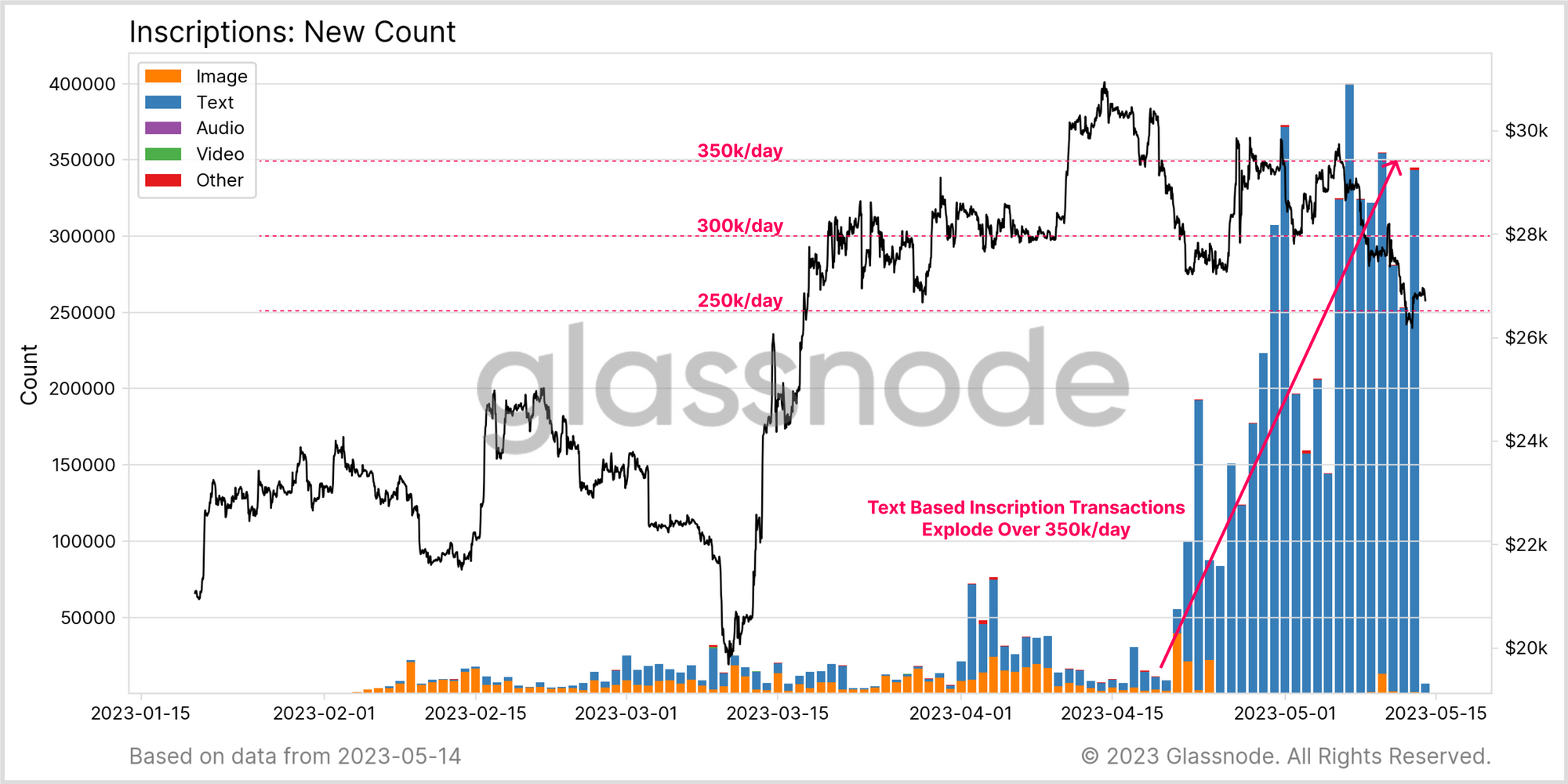
Out of the pool of total confirmed transactions, text based inscriptions accounted for over 50% of them. This is significantly higher than the 5% to 20% dominance seen with image inscriptions in the first wave, demonstrating the scale of this wave of demand.
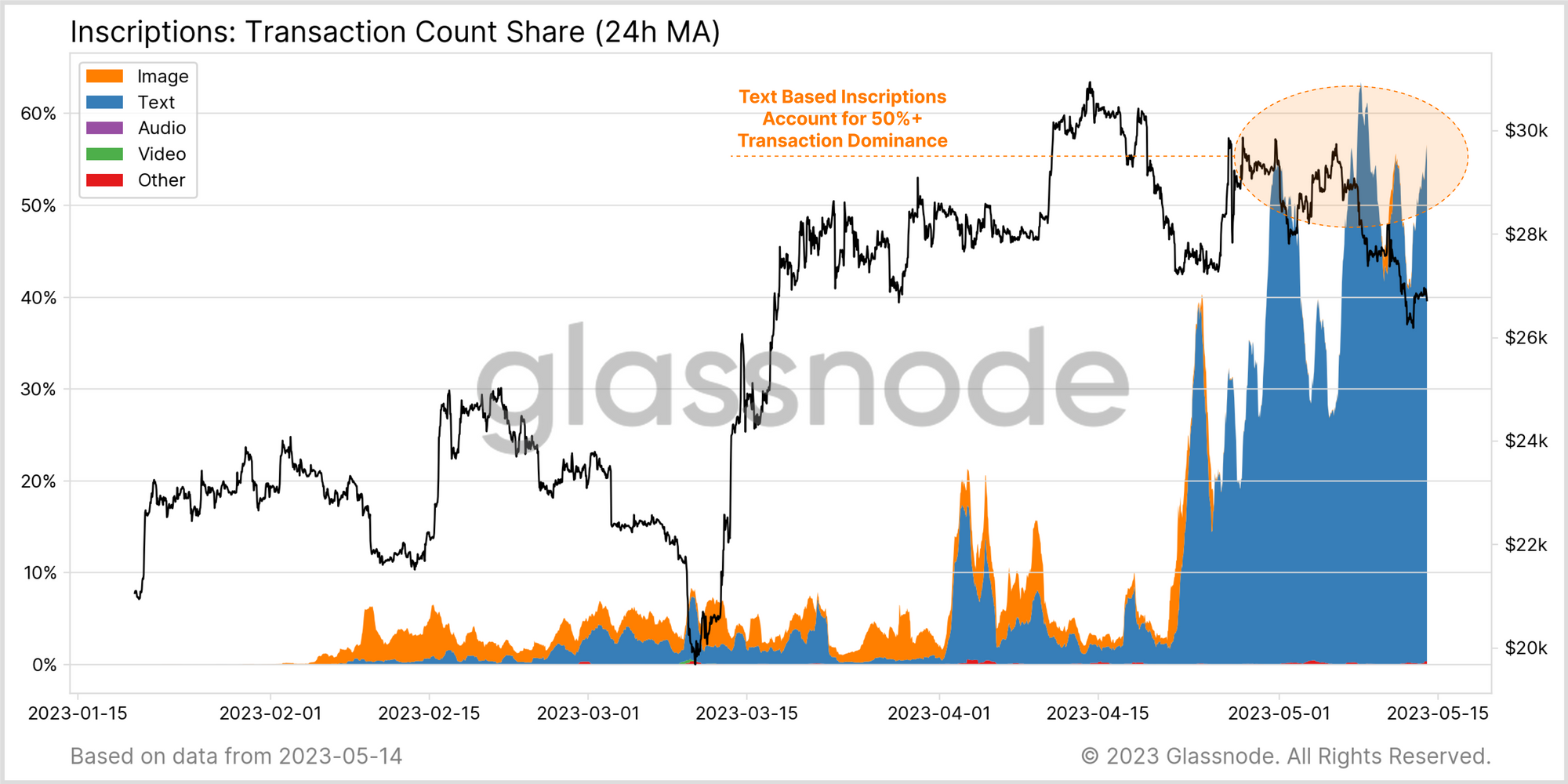
As a result, the total number of text inscriptions to date has firmly eclipsed those of images, surpassing by 5-million in number. There is now almost a full order of magnitude more text based vs image based inscriptions, having reached a total of 5.69-million text files written to the Bitcoin blockchain (accounting for 89% of the total so far).
Note, the y-axis of the chart below is in log-scale.
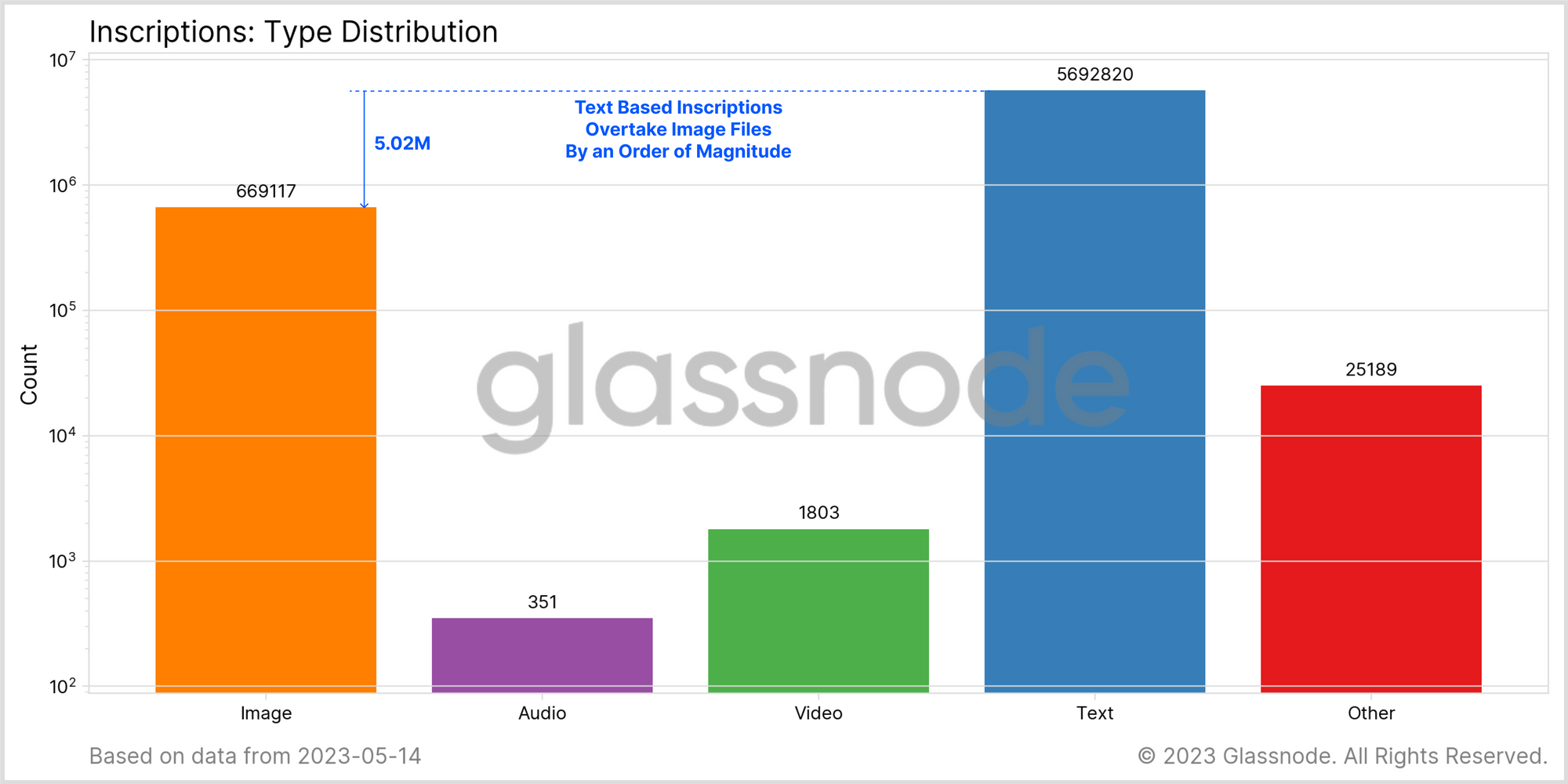
Miners Are Paid a Brief Bonus
The extreme urgency of BRC-20 transactors is captured the the extraordinary fees they paid for the experience. As congestion in our Bitcoin mempool reached fever pitch, fee pressure rose dramatically.
For only the fifth time in history, the average fee paid per block surpassed the block subsidy, with the last instance being at the 2017 market peak. For all five of these events, the period of high fee pressure was short-lived, and subsided after just a few days.
At the height of the BRC-20 mania, the average mined block was paying 6.66 BTC in fees, making for a total reward of 12.9 BTC per block (~$348k).
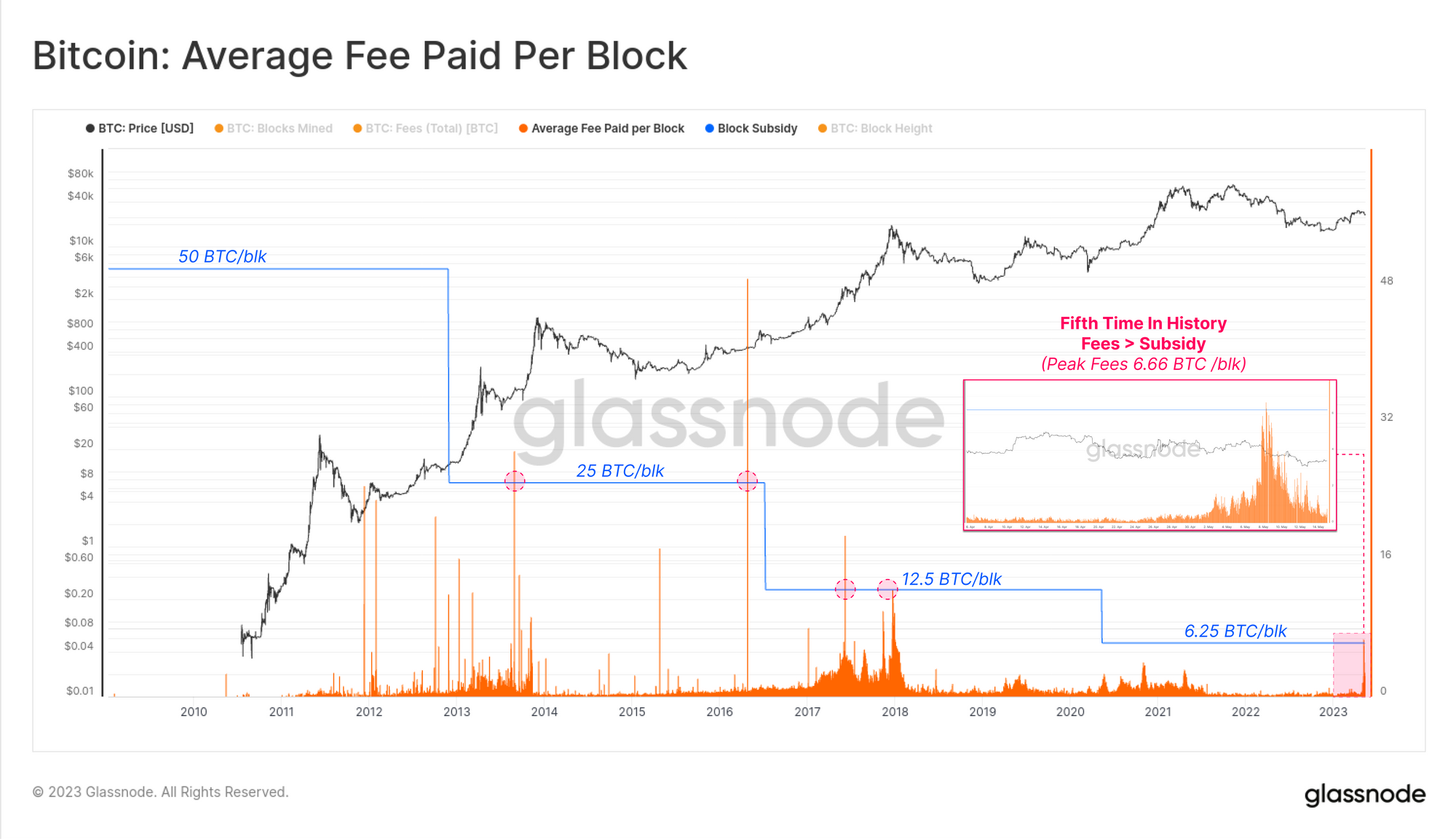
Text files during this second wave accounted for between 30% and 60% of total fees paid, which is significantly higher than the 5% to 20% typically seen during the first wave if image inscriptions.

In total, inscriptions have paid a cumulative sum of 1,262 BTC in fees to miners, with 1,090 BTC (86%) of this occurring during the last week. The chart below shows just how explosive the fee pressure associated with text files has been.
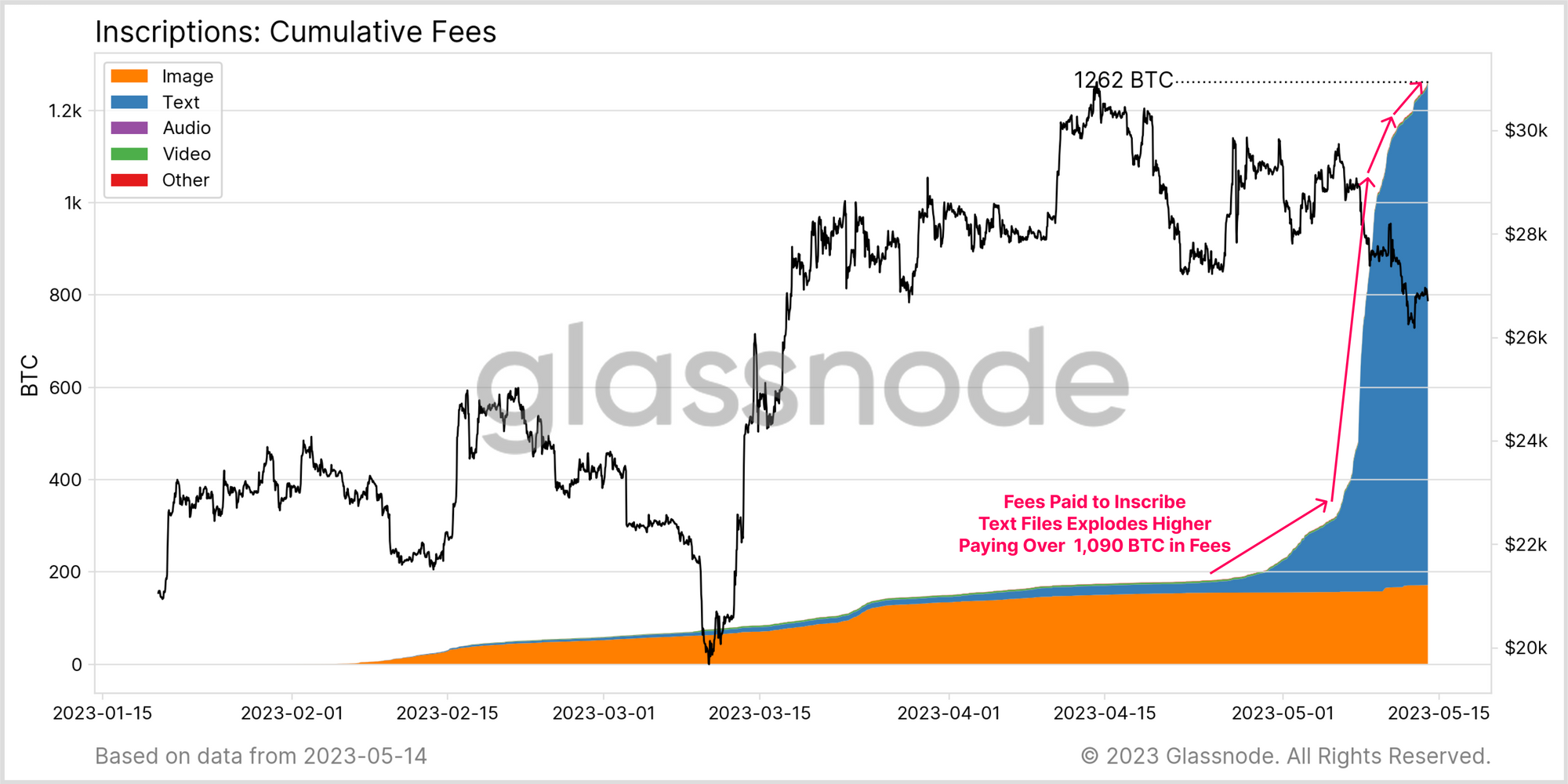
With this rapid rise in demand for Bitcoin blockspace, the total USD denominated fees paid per day almost set a new all-time-high, peaking at $17.8M/day. A challenging side effect of this was that the cost of sending a regular Bitcoin transaction also reached extreme heights, with the median and mean fee required to get a transaction included in a block hitting $20.17 and $30.80, respectively.
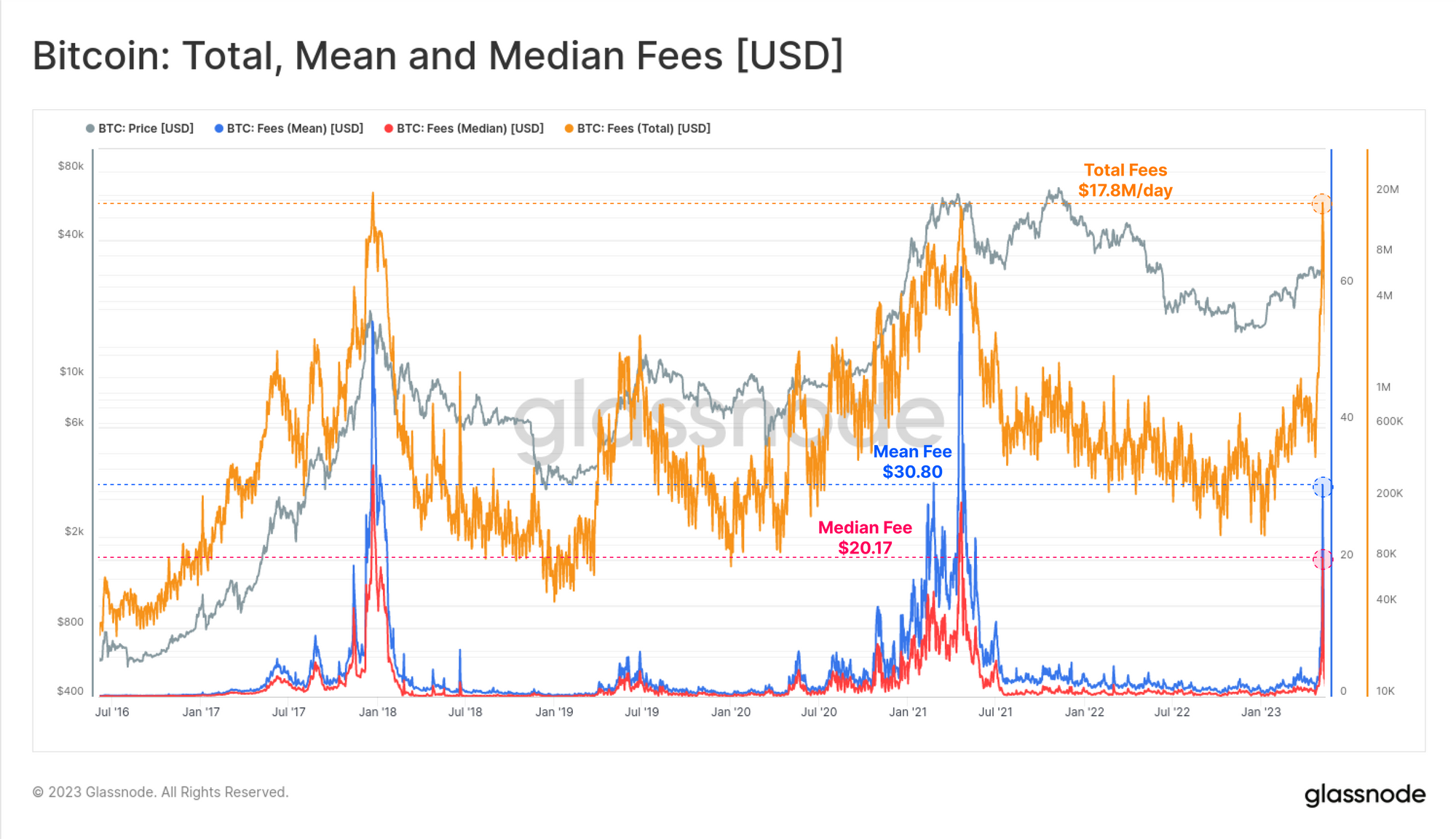
Over the last month the spot price of BTC has traded between $26k and $30k. Over this same period, miners have earned $773M in revenue from the 6.25 BTC block subsidy. With this recent bump in fee pressure, miners have earned an additional $100M in aggregate revenue.
As a result, the proportion of miner revenue associated with fees reached 11.5%, which is coincident with the elevated levels seen in both the 2017, and 2021 bull market periods.
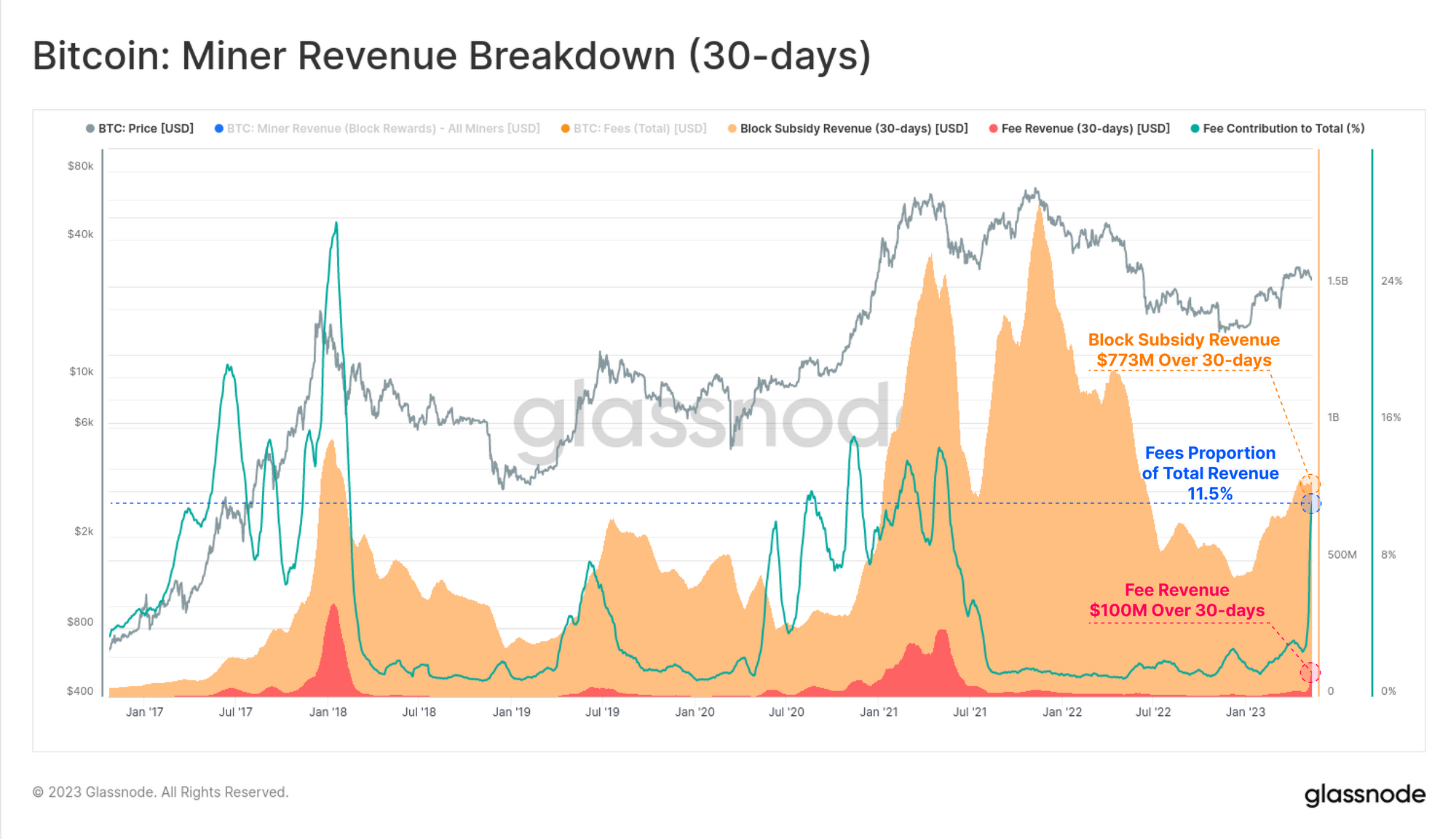
The acceleration of fee pressure is also historically significant. The chart below presents a series of Z-Scores for miner fee revenue, with training windows ranging from 1-year, to 4-years. The aim is to identify periods where fee pressure has risen in a statistically significant way across a wide range of market conditions.
On the shorter 1y-2y windows, the acceleration of fee pressure is arguably the fastest in history, comparable only to the 2011 era when Bitcoin barely had a year of price history. On the longer-term 3y-4y windows, fee pressure rose faster and larger than the 2021 bull market, and is best compared to the 2013 and 2017 bull markets.
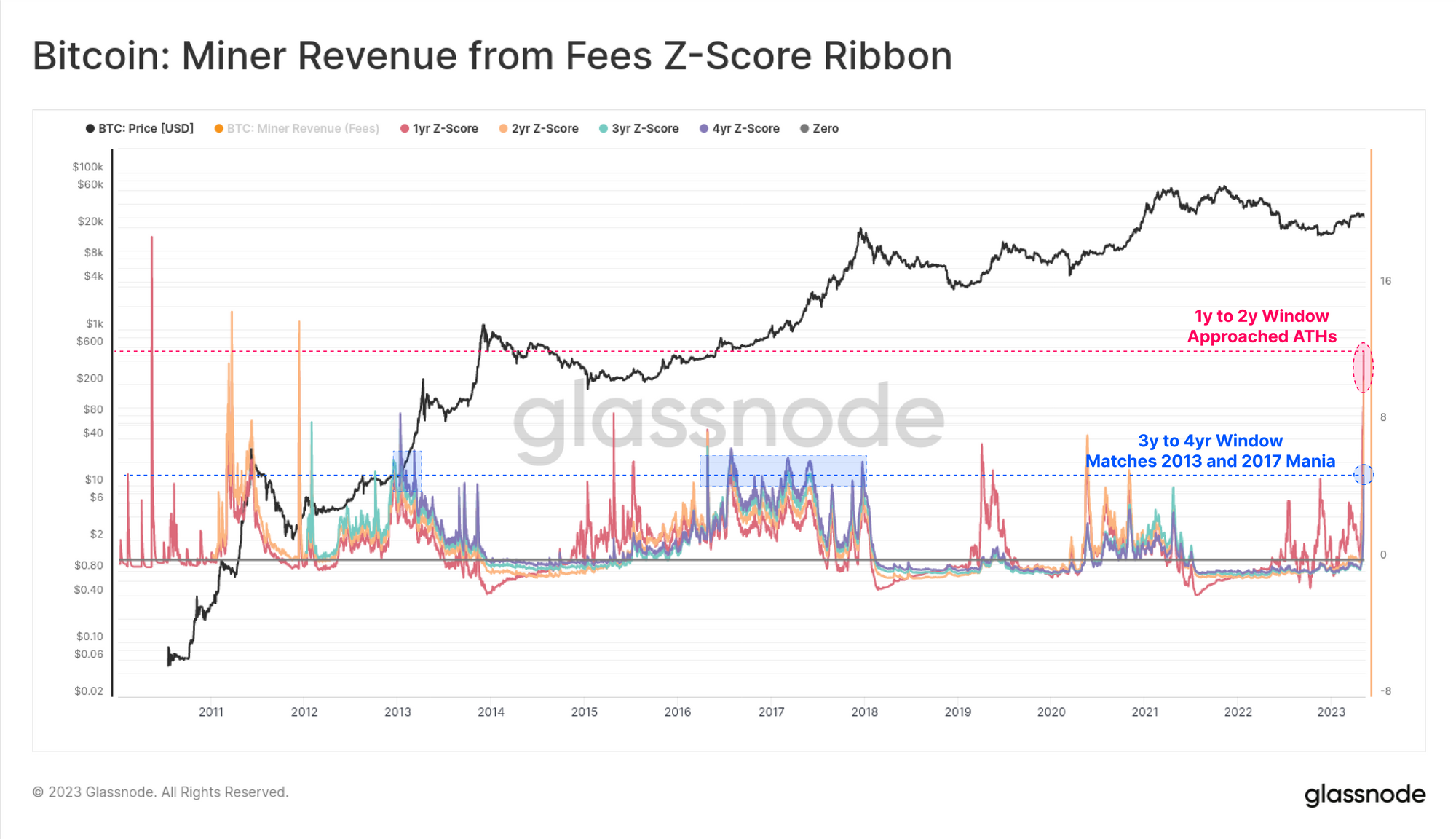
The USD revenue earner per Exahash, often called the hash-price, is the ideal tool for assessing the impact to miner revenues. It accounts not only for the BTC spot price, and fee pressure, but also for the estimated hashrate that is competing to earn the reward.
Hash-price briefly ticked up to $172.2k/EH this week, however has since collapsed by 55%, back to $76.3k/EH as fee pressure subsided. Whilst this burst of blockspace demand provided a positive uptick in miner revenues, it is short-lived thus far, and pales in comparison to the relentless downtrend (in log-scale) of hash-price.
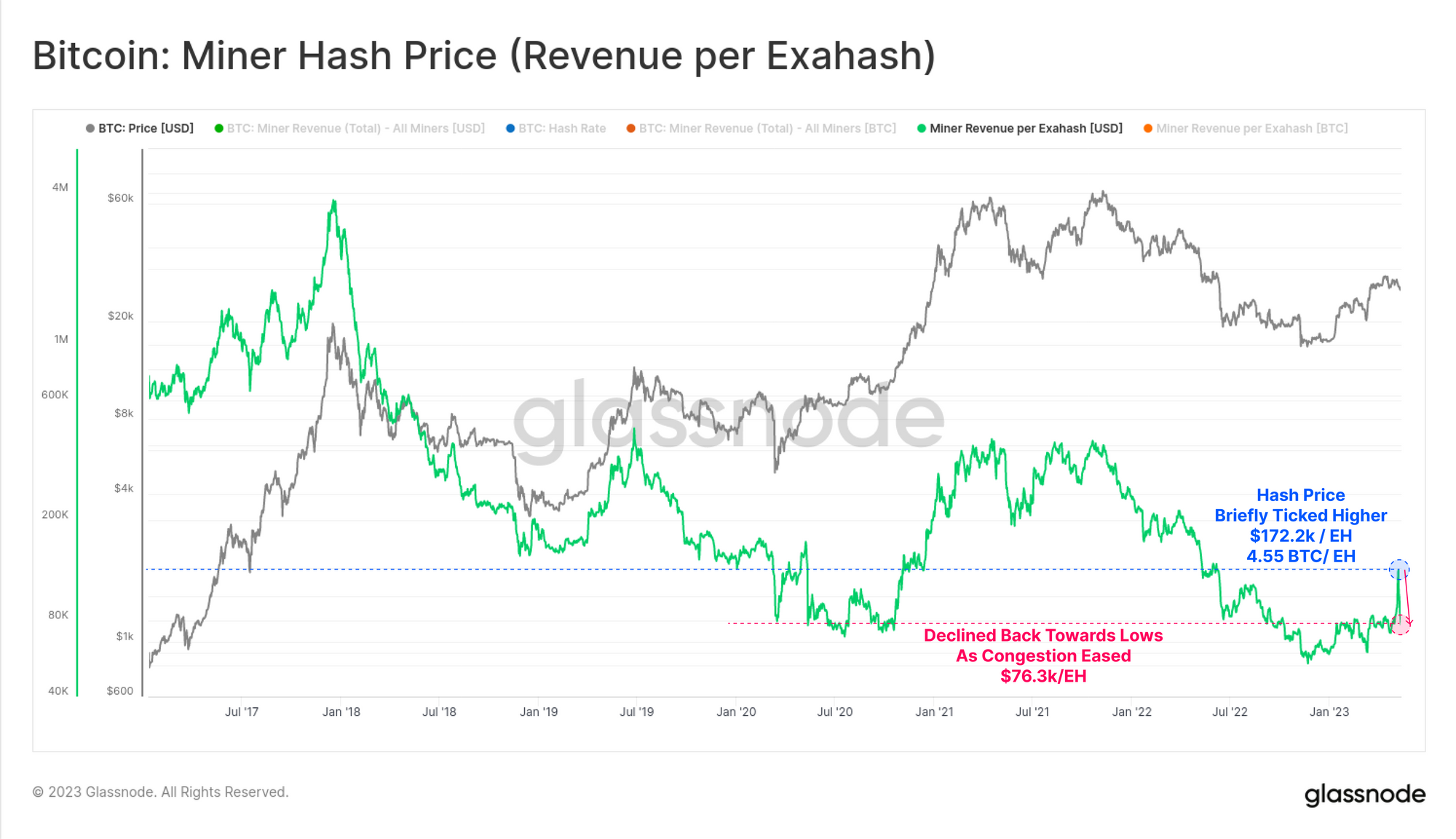
Out of the 3,275 BTC in total fees paid to miners over the last 2-weeks, the aggregate miner balance has only increased by 655 BTC, approximately 20% of the fees paid. The blue trace below shows the proportion of newly mined BTC that miners are spending, and it continues to oscillate around 100%.
Overall, whilst miners no doubt enjoyed the revenue uptick, it appears the majority of it was distributed, likely providing relief after the brutal downtrend that was the 2022 bear market.
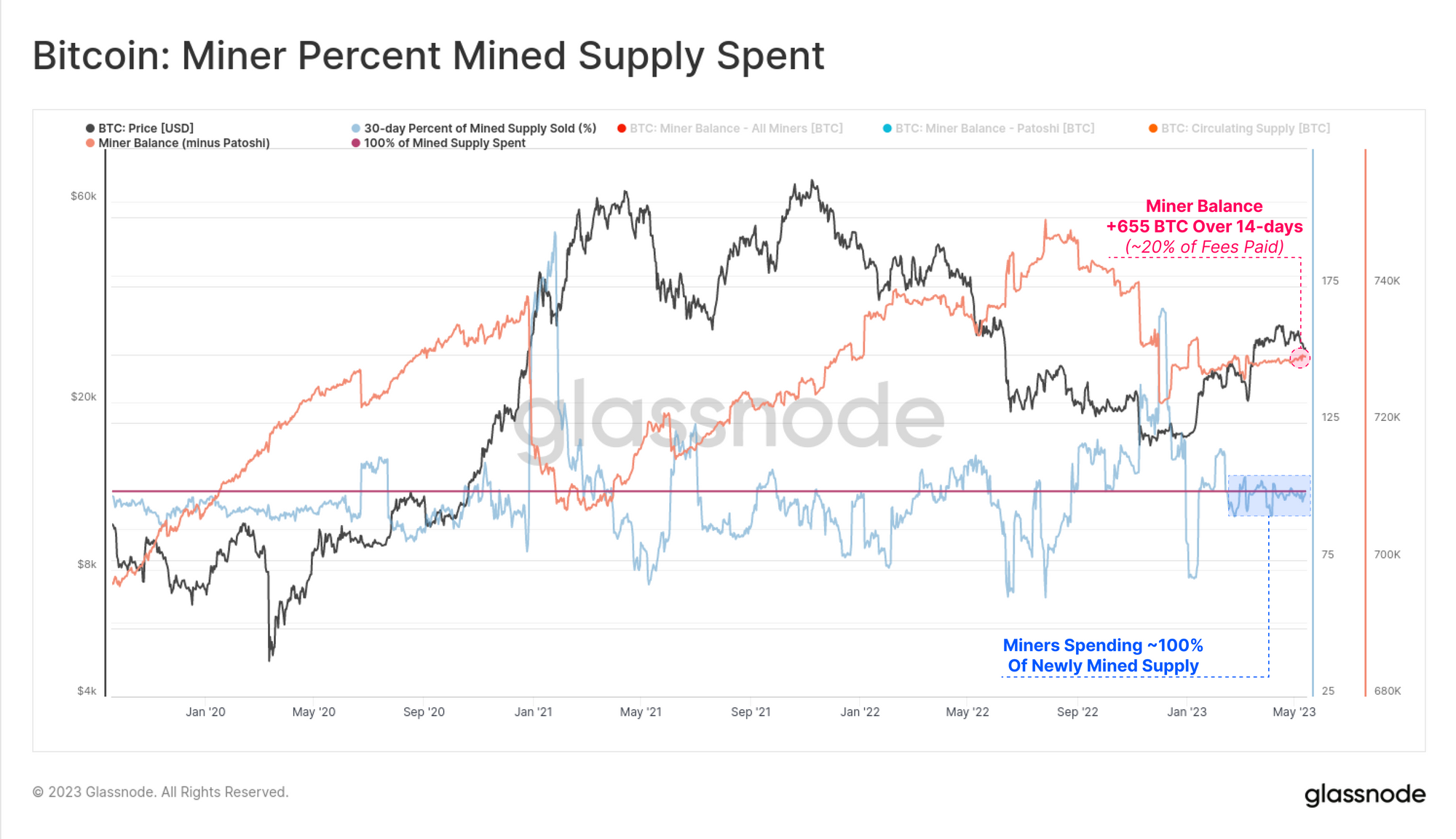
Summary and Conclusions
The emergence of Ordinals, Inscriptions, and now BRC-20 tokens continues to be one of the more unexpected developments in Bitcoin, sparking healthy debate about the technical, practical, and philosophical merits. What is known, is that so far, these technologies have given rise to a new buyer for Bitcoin blockspace, both at the lower, and now upper bounds of fee rates paid.
This week saw aggregate fees paid surpass the block reward for only the fifth time in history. The event pushed USD denominated fee revenue almost to new ATHs of $17.8M/day, and provided miners with a sorely needed revenue boost after 2022.
It remains to be seen whether Inscriptions and BRC-20 tokens have staying power long-term, however it does give us a new lens through which to observe demand for the settlement assurances of Bitcoin.
Disclaimer: This report does not provide any investment advice. All data is provided for information and educational purposes only. No investment decision shall be based on the information provided here and you are solely responsible for your own investment decisions.
. Join our Telegram channel.
. Visit Glassnode Forum for long-form discussions and analysis.
. For on-chain metrics, dashboards, and alerts, visit Glassnode Studio.
. For automated alerts on core on-chain metrics and activity on exchanges, visit our Glassnode Alerts Twitter.


